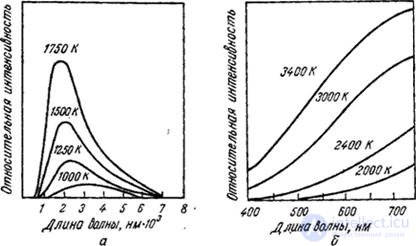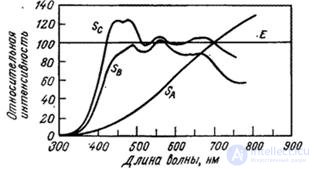Lecture
The source of radiant energy is described by the spectral density  - the rate of energy emission in a unit wavelength range. The total radiation power of the source is determined by the integral spectral density - the radiant flux
- the rate of energy emission in a unit wavelength range. The total radiation power of the source is determined by the integral spectral density - the radiant flux
 (3.1.1)
(3.1.1)
This value is usually measured in watts.
A body that has a higher temperature than the environment emits electromagnetic energy. The higher the temperature, the stronger the radiation. The ideal heat source is called a completely black body. The radiant flux of an absolutely black body at any value of the wavelength reaches the maximum possible for a given temperature. The spectral density of radiation is determined by Planck’s law [1]
 (3.1.2)
(3.1.2)
Where  - radiation wavelength,
- radiation wavelength,  - Body temperature,
- Body temperature,  ,
,  - permanent. In fig. 3.1.1, and shows graphs of the spectral density for different temperatures. In the visible region of the electromagnetic spectrum, the radiation density of an absolutely black body radiation can be approximated by the Wien law [1]:
- permanent. In fig. 3.1.1, and shows graphs of the spectral density for different temperatures. In the visible region of the electromagnetic spectrum, the radiation density of an absolutely black body radiation can be approximated by the Wien law [1]:
 (3.1.3)
(3.1.3)
The graph of the Wien function for the visible spectrum is shown in Fig. 3.1.1, b.
The main source of light is, of course, the sun. In fig. 2.1.1,  shows a graph of the measured spectral energy distribution of sunlight [2]. The dashed line in this figure, approximating the measurement results, is a graph of the spectral density of a black body radiation at
shows a graph of the measured spectral energy distribution of sunlight [2]. The dashed line in this figure, approximating the measurement results, is a graph of the spectral density of a black body radiation at  To Incandescent bulbs are also often approximated as an absolutely black body with
To Incandescent bulbs are also often approximated as an absolutely black body with  To [3].
To [3].

Fig. 3.1.1 Blackbody radiation [1]: a - Planck's law; b - the law of wine.
The International Commission on Illumination (CIE) has approved several standard light sources, the spectral radiation densities of which are graphically presented in Fig. 3.1.2 [4]. A source  There is a filament lamp with a tungsten filament. A source
There is a filament lamp with a tungsten filament. A source  gives light close to direct sunlight in the range of 400-700 nm. Light source
gives light close to direct sunlight in the range of 400-700 nm. Light source  close to light with a cloudy sky. A source
close to light with a cloudy sky. A source  with a uniform spectral density of radiation is often used in colorimetric calculations.
with a uniform spectral density of radiation is often used in colorimetric calculations.
In image processing systems, CRT tubes are often used as light sources. In fig. 3.1.3 presents the spectral radiation density of several conventional phosphors [5].

Fig. 3.1.2. Standard sources of MCO [4].

Fig. 3.1.3. The spectral density of emission of kinescope phosphors [5].
Monochrome television receivers usually use the P4 phosphor, which provides for the reproduction of a rather bright bluish-white picture. The phosphor P16 is used in video sensors of the running beam, as it has a short afterglow. For video sensors of a running beam of color television, a P24 phosphor, emitting in a relatively wide spectral band and having a rather short afterglow, is chosen. Color television receivers use kinescopes with red, green, and blue phosphors arranged in a triad of points or stripes. P22 Phosphor is a typical combination of three phosphors.
Comments
To leave a comment
Digital image processing
Terms: Digital image processing